Aerial Monitoring of Power Lines: Surveillance From Above for Grid Maintenance
Aerial Transmission Line Patrols: Safeguarding the Power Grid
The intricate network of power lines that crisscross North America is a critical component of our daily lives, supplying electricity to homes, businesses, and communities. To ensure the reliability and safety of this network, aerial transmission line patrols play a crucial role.
These patrols, primarily conducted by helicopters and drones, offer several advantages over traditional ground inspections. They are faster, covering vast stretches of transmission lines, sometimes over rough or inaccessible terrain, without delays. This speed is particularly valuable in identifying defects, damages, or potential hazards, allowing utilities to schedule timely maintenance and repairs [1][4].
Helicopters, due to their longer range, endurance, and payload capacity, dominate the industry. A typical Bell 407 helicopter can inspect 170 miles (273 km) of transmission line with a single takeoff and landing, while UAV patrols often have to operate within line-of-sight of the operator, land frequently for battery changes, and are slower than helicopter patrols [1].
The primary purpose of these flights is aerial transmission line patrols, which are crucial for maintaining the reliability of the power grid, especially during a shift towards renewable energy sources. They support critical functions such as vegetation management along rights-of-way and storm preparedness by identifying vulnerabilities before or after severe weather events [3].
The Minimum Vegetation Clearance Distances (MVCD) for both AC and DC systems, as defined by FAC-003-5, increase with the nominal line voltage and elevation. This is to prevent vegetation contacts that can cause outages in the power grid [2]. LiDAR sensors are often used to assess vegetation encroachments into the ROW, providing 3-dimensional visualizations of the transmission lines, their supporting structures, the ground below, and everything within and adjacent to the ROW [5].
Corona discharge, an early warning system for potential flashovers in the power grid, occurs when the air surrounding a conductor becomes ionized, turning into a conductive plasma. This phenomenon is particularly likely to happen at places where the electric field is concentrated, such as sharp points, and is often caused by faults that lead to their formation, such as broken strands in conductors [6].
Corona discharge emits a characteristic purplish-blue glow due to the emission of photons in the ultraviolet part of the EM spectrum. Specialized corona discharge cameras are used to detect corona faults, using a "solar blind" filter to filter out the abundant UV-A and UV-B light in sunlight and leaving only shortwave UV-C light below 280 nm in wavelength [7].
Nitrogen oxides and nitric acid, which can strip the zinc coating from galvanized steel and attack passivated coatings on parts, are also formed as a result of corona discharge. Ozone, a powerful oxidizer, is formed as a result of corona discharge and can quickly corrode aluminum in conductors and steel in the support structure [8].
The power grid in North America is regulated by the Federal Energy Regulatory Commission (FERC) in the United States. FERC delegates its standards-setting and enforcement authority to the National Electric Reliability Corporation (NERC), which was created in response to power outages in the Northeast United States in 1965 and 2003 [9]. FERC and NERC regulations, such as FAC-003-5, aim to prevent vegetation contacts that can cause outages in the power grid [10].
Mystery flights observed in air traffic data often follow odd patterns, with long straight stretches and occasional tight loops, and cover great distances across various landscapes. These flights are typically conducted by helicopters, are close to the ground, and sometimes have registrations indicating ownership by federal agencies [11].
In conclusion, aerial transmission line patrols are an essential part of proactive grid management, ensuring safe, reliable electric service through early detection of problems and efficient mobilization of repair resources [2][5]. They enable utilities to prevent minor issues from escalating into widespread power outages or system failures, thereby maintaining the reliability of the power grid.
- Sensors like LiDAR are often used in aerial transmission line patrols to assess vegetation encroachments and provide 3-dimensional visualizations, aiding in maintaining the reliability of the power grid.
- In the realm of environmental science and technology, aerial transmission line patrols are vital for functions such as vegetation management, ensuring the transition towards renewable energy sources remains smooth.
- While helicopters are commonly used in aerial transmission line patrols due to their advantages, data-and-cloud-computing and technology advancements may eventually lead to drones becoming more efficient, reducing the need for frequent battery changes.
- The travel patterns of helicopters conducting aerial transmission line patrols, often owned by federal agencies, can sometimes be seen as mystery flights due to their unusual flight paths across various landscapes, often indicative of important work being done in the finance and business sectors.




